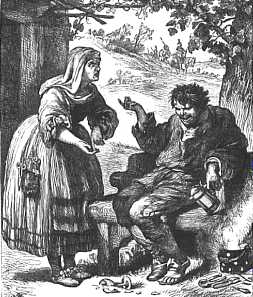Christopher Sly
One of the first problems presented to the reader is the relationship of the opening -- or "induction" -- scenes to the main play, which provide a sort of a "frame" for the main play. Sly, the audience for whom the play is performed, is the subject of ridicule, as he is fooled by the Lord (who may originally have been played by Shakespeare himself) into believing himself to be a noble. The goofiness of the fish-out-of-water motif provides moments of comedy when Sly misuses language and believes the Lord's page, dressed up as a woman, to be his wife.
The relationship between these scenes and the play's main action is difficult to pin down. In Shakespeare's play, Sly disappears entirely after act one and the frame seems entirely forgotten thereafter; modern performances often complete the frame by adding the relevant sections from The Taming of a Shrew.
In several plays, Shakespeare uses the device of a "play within the play," often to parody earlier acting styles.
